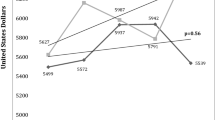Abstract
Background
Minimally invasive surgery (MIS) is associated with decreased complication rates, length of hospital stay, and cost compared with laparotomy. Robotic-assisted surgery—a method of laparoscopy—addresses many of the limitations of standard laparoscopic instrumentation, thus leading to increased rates of MIS. We sought to assess the impact of robotics on the rates and costs of surgical approaches in morbidly obese patients with uterine cancer.
Methods
Patients who underwent primary surgery at our institution for uterine cancer from 1993 to 2012 with a BMI ≥40 mg/m2 were identified. Surgical approaches were categorized as laparotomy (planned or converted), laparoscopic, robotic, or vaginal. We identified two time periods based on the evolving use of MIS at our institution: laparoscopic (1993–2007) and robotic (2008–2012). Direct costs were analyzed for cases performed from 2009 to 2012.
Results
We identified 426 eligible cases; 299 performed via laparotomy, 125 via MIS, and 2 via a vaginal approach. The rates of MIS for the laparoscopic and robotic time periods were 6 % and 57 %, respectively. The rate of MIS was 78 % in this morbidly obese cohort in 2012; 69 % were completed robotically. The median length of hospital stay was 5 days (range 2–37) for laparotomy cases and 1 day (range 0–7) for MIS cases (P < 0.001). The complication rate was 36 and 15 %, respectively (P < 0.001). The rate of wound-related complications was 27 and 6 %, respectively (P < 0.001). Laparotomy was associated with the highest cost.
Conclusions
The robotic platform provides significant health and cost benefits by increasing MIS rates in this patient population.

Similar content being viewed by others
References
Siegel RL, Miller KD, Jemal A. Cancer statistics, 2015. CA Cancer J Clin. 2015;65:5–29.
Leitao MM, Barakat RR (2014) Endometrial cancer prevention. In: Alberts D, Hess L (eds.) Fundamentals in cancer prevention, 3rd edition, pp. 593–612. Springer, Berlin
Ogden CL, Carroll MD, Kit BK, Flegal KM. Prevalence of childhood and adult obesity in the United States, 2011-2012. JAMA. 2014;311:806–14.
Finkelstein EA, Trogdon JG, Cohen JW, Dietz W. Annual medical spending attributable to obesity: payer- and service-specific estimates. Health Affairs. 2009; 28:w822–31.
Leitao Jr MM, Barakat RR. Advances in the management of endometrial carcinoma. Gynecol Oncol. 2011;120:489–92.
Walker JL, Piedmonte MR, Spirtos NM, et al. Laparoscopy compared with laparotomy for comprehensive surgical staging of uterine cancer: Gynecologic Oncology Group Study LAP2. J Clin Oncol. 2009;27:5331–6.
Kornblith AB, Huang HQ, Walker JL, Spirtos NM, Rotmensch J, Cella D. Quality of life of patients with endometrial cancer undergoing laparoscopic International Federation of Gynecology and Obstetrics staging compared with laparotomy: a Gynecologic Oncology Group study. J Clin Oncol. 2009;27:5337–42.
Walker JL, Piedmonte MR, Spirtos NM, et al. Recurrence and survival after random assignment to laparoscopy versus laparotomy for comprehensive surgical staging of uterine cancer: Gynecologic Oncology Group LAP2 study. J Clin Oncol. 2012;30:695–700.
Leitao Jr MM, Briscoe G, Santos K, et al. Introduction of a computer-based surgical platform in the surgical care of patients with newly diagnosed uterine cancer: outcomes and impact on approach. Gynecol Oncol. 2012;125:394–9.
Leitao Jr MM, Bartashnik A, Wagner I, et al. Cost-effectiveness analysis of robotically assisted laparoscopy for newly diagnosed uterine cancers. Obstet Gynecol. 2014; 123:1031–7.
Grobmeyer SR, Pieracci FM, Allen PJ, et al. Defining morbidity after pancreaticoduodenectomy: use of a prospective complication grading system. J Am Coll Surg. 2007; 204:356–64.
Gunderson CC, Java J, Moore KN, Walker JL. The impact of obesity on surgical staging, complications, and survival with uterine cancer: a Gynecologic Oncology Group LAP2 ancillary data study. Gynecol Oncol. 2014;133:23–7.
Gehrig PA, Cantrell LA, Shafer A, Abaid LN, Mendivil A, Boggess JF. What is the optimal minimally invasive surgical procedure for endometrial cancer staging in the obese and morbidly obese woman? Gynecol Oncol. 2008;111:41–5.
Seamon LG, Bryant SA, Rheaume PS, et al. Comprehensive surgical staging for endometrial cancer in obese patients. Obstet Gynecol. 2009;114:16–21.
Lau S, Buzaglo K, Vaknin Z, et al. Relationship between body mass index and robotic surgery outcomes of women diagnosed with endometrial cancer. Int J Gynecol Cancer. 2011;21:722–9.
Subramaniam A, Kim KH, Bryant SA, et al. A cohort study evaluating robotic versus laparotomy surgical outcomes of obese women with endometrial carcinoma. Gynecol Oncol. 2011;122:604–7.
Bernardini MQ, Gien LT, Tipping H, Murphy J, Rosen BP. Surgical outcome of robotic surgery in morbidly obese patient with endometrial cancer compared to laparotomy. Int J Gynecol Cancer. 2012;22:76–81.
Tang KY, Gardiner SK, Gould C, Osmundsen B, Collins M, Winter III WE. Robotic surgical staging for obese patients with endometrial cancer. Am J Obstet Gynecol. 2012;206:5131–6.
Stephan J, Goodheart MJ, McDonald M, Hansen J, Reyes HD, Button A, Bender D. Robotic surgery in supermorbidly obese patients with endometrial cancer. Am J Obstet Gynecol. 2015;213:491–8.
Franchi M, Ghezzi F, Buttarelli M, Tateo S, Balestreri D, Bolis P. Incisional hernia in gynecologic oncology patients: a 10-year study. Obstet Gynecol. 2001;97:696–700.
Acknowledgment
Funded in part by the cancer center core Grant P30 CA008748.
Conflicts of interest
The authors have no conflicts of interest or funding to disclose.
Author information
Authors and Affiliations
Corresponding author
Electronic supplementary material
Below is the link to the electronic supplementary material.
Rights and permissions
About this article
Cite this article
Leitao, M.M., Narain, W.R., Boccamazzo, D. et al. Impact of Robotic Platforms on Surgical Approach and Costs in the Management of Morbidly Obese Patients with Newly Diagnosed Uterine Cancer. Ann Surg Oncol 23, 2192–2198 (2016). https://doi.org/10.1245/s10434-015-5062-6
Received:
Published:
Issue Date:
DOI: https://doi.org/10.1245/s10434-015-5062-6




